
Project News
STRAIGHTSOL Newsletter - Issue 6 available (pdf, 688Kb)
[More]
See our animations
[More]
New deliverables available
[More]
Summary results booklet available
[More]
STRAIGHTSOL evaluation framework resources available
[More]
Open ENLoCC event videos available
[More]
STRAIGHTSOL Newsletter - Issue 5 available (pdf, 193Kb)
[More]
Kuehne-Nagel's video: Rail tracking and warehouse management (6:50 mins)
[More]
Demonstration poster presentations available to download
[More]
Tuesday 23rd April 2013 - Batley, W. Yorkshire
STRAIGHTSOL Demonstration Workshop
Oxfam - Remote 'bring-site' monitoring for reactive and sustainable logistics
Presentations
- Introduction to STRAIGHTSOL project, Jardar Andersen (TØI)
- Introduction to Oxfam and its role within STRAIGHTSOL, Lindsay Ryan (Oxfam)
- Remote monitoring waste collection assets, Seamus Devitt (Smartbin)
- Off-line evaluation and initial demonstration results, Tom Cherrett and Fraser McLeod (University of Southampton)
- Experiences from other users of remote monitoring, Seamus Devitt (Smartbin)
Workshop report
Introduction
The Oxfam demonstration is using remote monitoring of charity donation banks to provide regular data on bank fill levels. In the demonstration, these data are being used to try to improve the efficiency of collections (i.e. reducing mileage); the data may also be useful for asset monitoring and evaluation, and for identifying possible instances of theft from banks. The Oxfam demonstration workshop took place on Tuesday 23rd April 2013 at Oxfam's recently opened Northern Logistics Centre at Batley, West Yorkshire, UK. The move to the new premises (Figure 1) was only made at the start of April 2013, and was required after a major fire in April 2011 had largely destroyed their previous premises at Huddersfield (Figure 2).
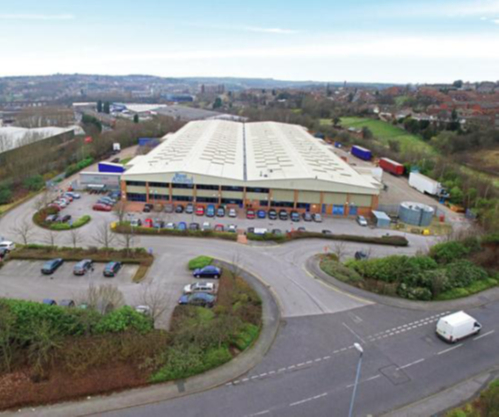
Figure 1: Oxfam's new premises at Batley
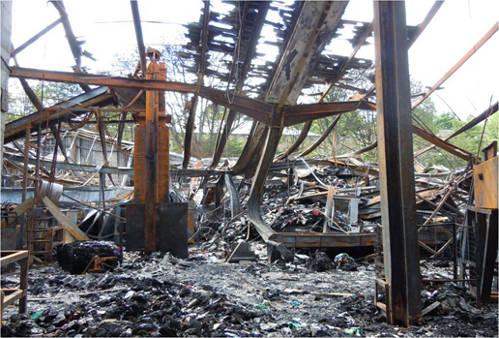
Figure 2: Oxfam's former premises after the fire
Aside from the Straightsol project partners and 3 members of the Straightsol European Reference Group (expert advisors to the project), the event attracted participants from the following organisations:
- Salvation Army - a major charity, who also employ a large number of donation banks nationwide.
- Recycling officers from local authorities (Leeds, Kirklees, Richmondshire), with responsibilities for servicing banks, typically used for collecting glass.
- WRAP (Waste and Resources Action Programme) - a not-for-profit company, backed by UK government and EU funding, which aims to help UK businesses, local authorities, communities and individuals reap the benefits of reducing waste, developing sustainable products and using resources in an efficient way.
- ITS (UK) – the UK association for the promotion of intelligent transport systems.
- Smartfusion project, having similar objectives and with whom Straightsol collaborated at the first Straightsol project-level workshop (Brussels, 3/7/2012).
- Smartbin, the provider of the remote monitoring technology.
- Aestiva Ltd – a consultancy established to work on novel projects to promote cradle-to-cradle precepts into clothing and fashion.
The event comprised a number of presentations (see above), stakeholder views, a discussion session, a live demonstration of the remote monitoring technology in action and a tour of the logistics centre.
Background
Oxfam works with local communities in the UK and worldwide to tackle problems associated with poverty. Their activities include food distribution, crop intensification, providing cash grants to stimulate local economies, maintaining livestock, providing sanitation and safe drinking water and health/hygiene education to prevent disease. Their trading company Oxfam opened the first-ever charity shop in 1947 and today has built a network of over 20,000 volunteers across 700 shops, an on-line shop, and using around 1500 donation banks nationwide. The facility at Batley (the workshop venue) is used to process surplus textile from the shop and bank network, generating an additional £2m annual net contribution. The logistics associated with these operations (Figure 3) are quite demanding and Oxfam were motivated to use remote monitoring of banks for a number of reasons:
- To reduce overall transport costs
- To contribute towards 2020 carbon reduction targets
- To generate accurate management information
- To improve service quality through contractor management
- To alert unauthorised collections (theft) and pinpoint any patterns in these
- To provides robust production planning
- To allow managers to monitor fill levels on the go
- To create an accurate data source for on-going work
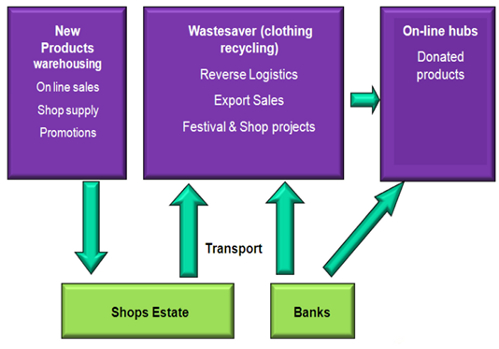
Figure 3: Oxfam logistics
The technology
Remote monitoring technology can be used for any container having a roof (as the sensor is installed on the underside of this) and for a wide range of material types, including those used for textiles, glass, metals, oils and grease and above and below ground containers (Figure 4). The sensors used in the demonstration are infra-red; ultrasonic sensors are used where detection of glass is required. The technology costs comprise purchase of the sensor plus on-going communications costs. [Note: Costs incurred during the demonstration were around £150 per sensor plus £11/sensor/month for communications.]

Figure 4: Various container types suitable for remote monitoring and Smartbin sensor
A number of technological challenges have been encountered during the demonstration:
- The remote monitoring sensors are reliant upon the availability of good GSM communications. This may not always be guaranteed in some parts of the demonstration area. It was noted that this is particularly a challenge where underground bins are used (not the case in the Straightsol demonstration).
- Oxfam have been improving the security of their banks by using thickened steel, however, this can result in a 'Faraday cage' effect where signals are unable to escape from the container, although this effect is ameliorated by the presence of the opening chute used to donate the goods.
- Earlier versions of the Smartbin sensor suffered from a short battery life due to repeated transmissions where signals were not received due to the above problems. This issue has been resolved in an updated version of the sensor.
- Vandals/thieves were disabling sensors by removing their battery. The battery is now contained within a sealed unit to prevent removal. This means that the sensor has to be replaced when the battery fails with an expected battery life of 5 years. The new sensors have also been secured to the banks using more rugged brackets than before to try to prevent unauthorised removal.
- The sensor must be positioned carefully to ensure that the view angle is as desired and not obstructed by the opening chute.
How the remote monitoring data can be used
Previous studies and applications in other industries (e.g. cardboard recycling, glass recycling, oil collections) have suggested that around a 25% vehicle mileage savings can be achieved through using remote monitoring data to schedule collections, with the greatest benefits being observed in situations where:
- The collection points are widely spread, where one wants to avoid lengthy journeys to outlying sites that may not contain much. Conversely, benefits are limited where the collection points are in roughly the same area (e.g. along an arterial route).
- Materials gather at varying rates, making it difficult to predict when the bank will become full.
In the Oxfam demonstration, both of the above situations occur, giving scope for benefits.
The University of Southampton have been supporting Oxfam in the demonstration through off-line evaluation and development of a vehicle routing and algorithm vehicle which suggests which sites should be visited on which days, based on the remote monitoring data. The algorithm works on the basis that banks should not be visited until they reach a certain specified fill level (e.g. 50%), nor should they be visited too late, with a penalty function being used to act as a 'hurry-up call' when the bank reaches a specified maximum target level (e.g. 75%). The algorithm is run each day to plan routes for the following day. Limitations of the algorithm (which could be addressed if considered worthwhile) were reported as:
- Fixed travel times between all sites (average values obtained from a vehicle routing package) are used as input to the algorithm. Traffic delays are therefore not explicitly considered; however, the user does have the facility to specify time window constraints which can be used to prevent busy urban areas (e.g. centre of Oxford or Cambridge) from being visited during the morning peak traffic period.
- The algorithm does not consider postponing collections to later in the week and has a tendency to schedule a collection if permitted to do so (i.e. bank over 50% full).
- No rerouting of vehicles during the working day (e.g. to respond to a bank suddenly receiving a large donation) is considered.
- The algorithm does not necessarily produce balanced workloads between drivers. For these reasons, it was emphasised that, during the demonstration, Oxfam's transport manager should use the algorithm as a tool to suggest routes, adapting these as required.
The off-line evaluation highlighted the strong influence shops have as part of the overall collection function. Because banks are typically situated in the vicinity of shops, visiting them as part of a scheduled shop 'milk round' collection does not add significantly to round mileage. This has been highlighted in the initial off-line results where profit gain has been negligible under some of the collection scenarios. The evaluation work has also shown the potential benefits of moving towards a dynamic shop collection approach, in essence, treating shops as banks and only organising a collection when an actual demand is identified. This evaluation had suggested that aiming to visit sites when at least 50% full gave the best results in terms of reducing associated time and distance. An audience member commented that the Salvation Army aim to visit their banks when 2/3rds full (based on historical data rather than dynamic data).
The enhanced network visibility created by the sensors can be used in other ways to generate profit by permitting more informed decision-making in response to new opportunities. At a local level, area managers and shop managers dealing with ad-hoc house clearance requests can visualise current bank fill levels in relation to the local driver's collection schedule and potentially over-ride part of the round in favour of servicing the house collection.
Secondary from the core objective in Straightsol of using the remote sensors to better optimise collection rounds, another area for exploitation relates to how the dynamic fill updates can be used to determine which areas should be targeted for future bank placement. Equipped banks can be put in new areas and the fill levels monitored over time to reveal specific trends e.g. weekend donation patterns. Various optimisation techniques could then be used to determine the most optimal placement strategy given the fill rates, the demographic characteristics of the area and where possible, back-end analyses have been undertaken to quantify the value of donations collected.
The delegate discussions showed that there was considerable interest in using the data to gain an understanding of illegal bank tampering across the network. This could be used for identifying the temporal and geographical patterns of theft. It could also be used for aiding the collection optimisation process by highlighting banks that could warrant a service, even when less than 40% full if they are recognised as a good profit source and in a high risk area. It was also noted that the remote monitoring data can help in identifying theft by drivers, by comparing expected volumes to be collected on the round with the actual volumes returned by the driver to the depot.
Stakeholder perspectives
Stakeholder views were provided by:
- Steve Smith – Regional Transport Manager, Oxfam Southern Logistics Centre, responsible for managing the demonstration
- Alison Jackson – Oxfam area manager (Berkshire & Buckinghamshire), responsible for 24 shops, with each shop having between 25 and 80 volunteers working part-time and managing a driver undertaking collections from shops, banks, a small number of businesses donating goods (e.g. Marks & Spencer) and ad hoc collections (e.g. house clearances) and moving stock between shops (known as 'cascading').
Their views are summarised in the following points:
- Planning vehicle routes on a daily basis involves considerably more effort for Oxfam's transport manager than currently, where vehicle rounds are reviewed on a weekly basis.
- The dynamic rounds present a challenge in being able to record the vehicle round data (volumes collected, mileage driven etc.) within their database (Podfather), as it has been designed for essentially fixed vehicle rounds. Although these rounds can be modified in Podfather, it would be a cumbersome and time consuming task to do this on a daily basis for dynamic collection schedules. Steve Smith is currently assessing how this challenge should best be tackled.
- Although not part of the demonstration plan, if Oxfam decided to service shops dynamically based on demand, in a similar way to the banks, they would have to consider the impacts on shop managers and shop volunteers in being able to cope with the resulting changes in operations. Storage space available at shops is also a prime consideration and it was observed that this varies widely between individual shops and that some space needs to be reserved to accommodate direct donations from members of the public.
- There was enthusiasm from Alison Jackson and the driver she manages for the Smartphone application, developed outside of the Straightsol project, which shows bank and shop locations on a map, displays Smartbin data via a link to the Smartbin webserver and facilitates recording of round information and communications between the various actors involved (e.g. drivers, shop managers, area manager). The app was considered to be particularly useful for responding quickly to ad hoc requests for house clearances and other ad hoc collections. Testing of the app had revealed some areas with poor 3G reception.
Other suggestions/opinions/questions from the discussion session
- A consideration with textiles is that a minimum collection frequency of once a week is probably needed as they may otherwise become damp and useless.
- Remote monitoring for theft detection and preventing overflowing sites seems to be very useful; I am not so sure of the merits of dynamic vehicle routing.
- Has Oxfam considered utilising their vehicles for making deliveries (perhaps on behalf of another company) on outbound legs where the vehicle is currently empty? [This has not been considered. Although desirable from the point of view of increasing load factor, such 'frontloading' activity would likely be difficult to obtain and manage and could detract from the core activity.]
- Once sufficient sensor data has been obtained it may be possible for it to be reliably used to make future predictions both for its own fill levels and for fill levels of neighbouring banks. In effect, the sensor could eventually make itself redundant. [Comment: This presupposes that donation rates are fairly regular and predictable, which remains to be seen.]
Live demonstration
The workshop included a live demonstration of the remote monitoring in action with an on-site equipped bank being filled with materials donated by the workshop participants (Figure 5). Normally the sensor is configured to transmit two only messages a day but for the purposes of the live demonstration, frequent updates were sent to the participants via SMS texting.
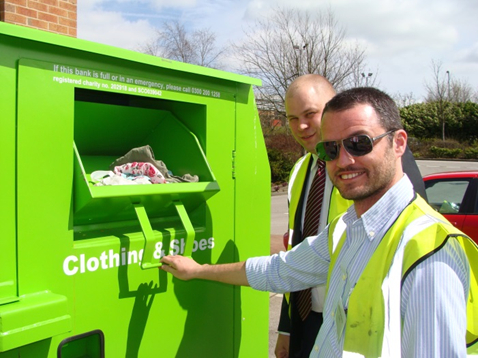
Figure 5: On-site donation bank
Tour of the facilities
The workshop concluded with a guided tour of Oxfam's Northern Logistics Centre, by Lorraine Needham-Brinley and David Waugh, showing the impressive scale of its operations. Donated materials are sorted into various grades according to the quality, saleable value and optimum market for the goods (Figure 6), with the highest value goods (e.g. designer labels) tending to be sold through its online shop operating out of the centre; more trendy goods being targeted for various festivals held throughout the year (e.g. Glastonbury music festival) and lowest grade materials being compacted and baled for sale to textile recycling merchants (Figure 7).
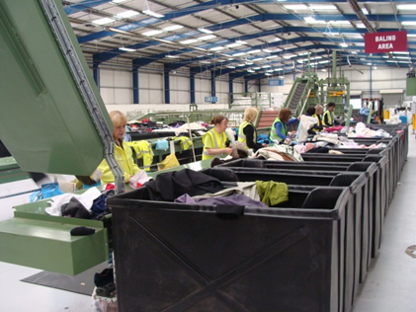
Figure 6: Sorting line
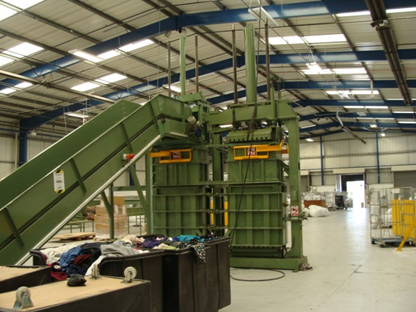
Figure 7: Compaction and baling of lower grade materials

Events
29/08/2014
Project Final Review meeting, Brussels
12/06/2014
Smart Urban Freight Conference hosted by NewRail, Newcastle University, including contributions from Straightsol project
[Conference webpage]
13/06/2014
Evaluation Framework Training Sessions, Newcastle University
[More]
02/04/2014
Open ENLoCC event, Brussels, including presentation of Colruyt and Delhaize night-time deliveries demonstration
[More]
24/09/2013
Demonstration Results Workshop/Exhibition in Amsterdam
[More]
02/07/2013
TNT Express demonstration workshop in Brussels
[More]
23/04/2013
Oxfam demonstration workshop in Batley, near Leeds, UK
[More]
07/03/2013
DHL Supply Chain demonstration workshop in L'Hospitalet de Llobregat/Barcelona, Spain
[More]
31/10/2012
Oslo: Demonstration workshop
Smart Urban Transport - Standardising information in retail supply chain management and last-mile distribution
[More]
13/09/2012
Thessaloniki: Demonstration workshop
"Intelligent" systems for the interconnection of urban-interurban freight transport
[More]
03/07/2012
Brussels: STRAIGHTSOL project workshop on Smart Urban Freight Solutions
(in collaboration with the Smartfusion partnership)
[More]